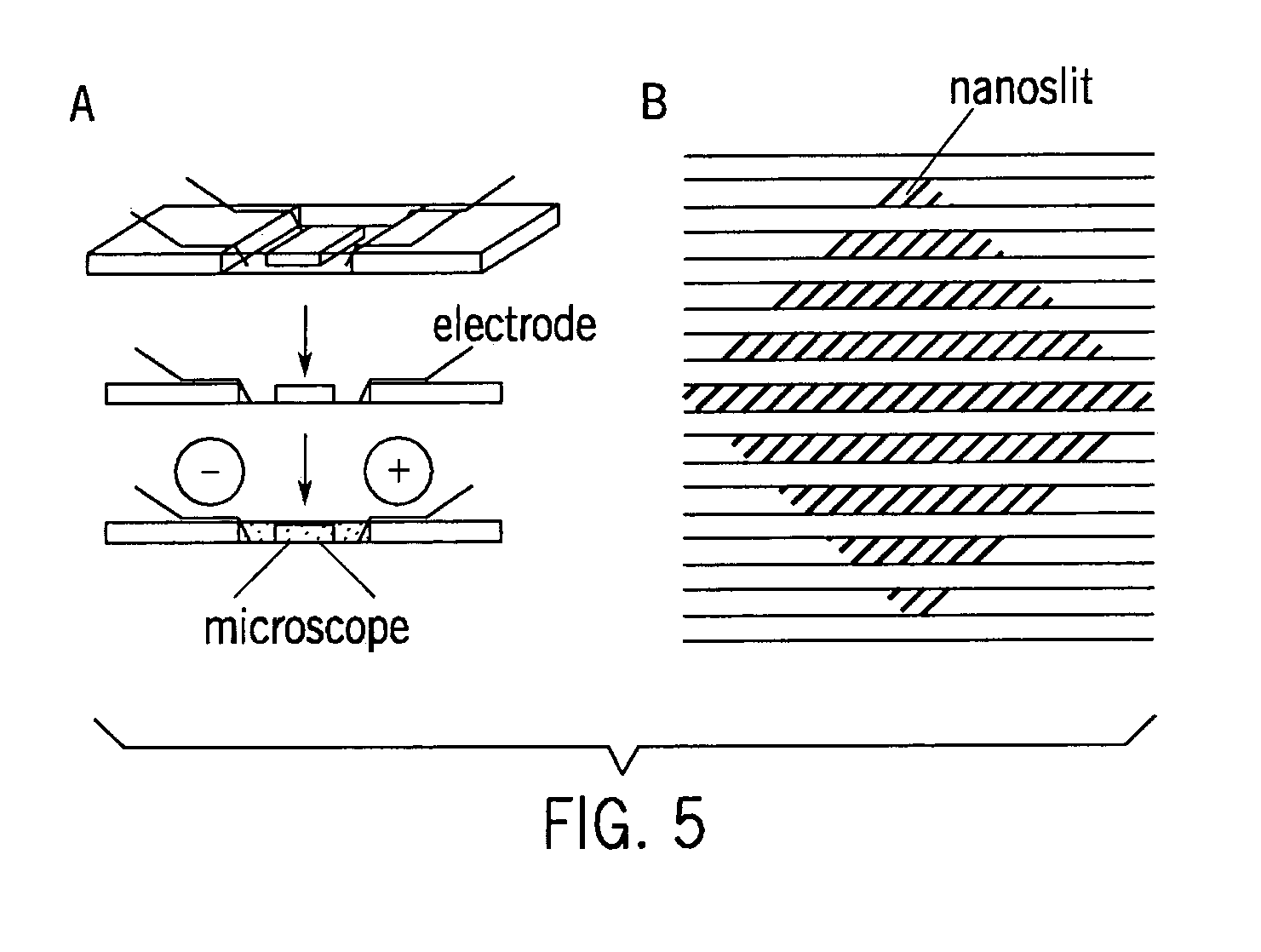Method of DNA analysis using micro/nanochannel
a micro-nanochannel and dna technology, applied in the field of presenting polymeric biomolecules, can solve the problems of difficult control of chemical interactions with dna, nanochannel use, and inability to cleave dna to be suitable for subsequent use, so as to increase the stiffness of the elongated dna molecule, increase the stiffness of the molecule, and increase the stiffness
- Summary
- Abstract
- Description
- Claims
- Application Information
AI Technical Summary
Benefits of technology
Problems solved by technology
Method used
Image
Examples
example 1
Construction of Nanochannel Devices
[0035] Fabrication of nanochannel devices followed standard soft lithography techniques known to one skilled in the art. Whitesides G, et al., “Soft lithography in biology and biochemistry,” Annu. Rev. Biomed. Eng. 3:335-373 (2001). To begin, a chrome mask, created with e-beam lithography at the University of Wisconsin Center for nanotechnology, was used as a mask in photolithography on negative photoresist spin-coated onto silicon wafers, creating an array of 1 μm channels. The wafer was etched to a depth of 100 nm by CF4 gas. Photoresist was lifted off by piranha solution. The height of the pattern was determined by an alpha step profilometer and the width of the pattern was measured under scanning electron microscope. After fabrication of the nanochannels, a microchannel array was overlaid on the nanopatterned wafer. SU-8 2005 photoresist was used to create channels 5 μm high and 100 μm wide. FIG. 5 shows the nanochannels (diagonal lines; 100 n...
example 2
Sequence-Specific Labeling of Nicked DNA
[0037] Sequence-specific labeled DNA was the result of the following steps: (1) linearization, (2) ligation, (3) nick site blocking, (4) nick translation, and (5) protein digestion. Linearization is required only when using circular DNA. Regardless of whether linearization was required, DNA ligase was used to remove inherent nicks in DNA. A DNA ligase reaction with T4 DNA ligase was performed at room temperature overnight. An overnight reaction ensures that ligation is complete and kills DNA ligase activity. To further ensure that and all inherent nicks were removed, DNA polymerase I (10 units) was added with dideoxy nucleotides (ddNTPs; 0.2 μM each) for 30 minutes at 37° C. ddNTPs incorporated into nicks block additional polymerase reaction and avoid random labeling. A nicking enzyme (N.BbvC1, 20 units; GCˆTGAGG) was then added with deoxynucleotides (dNTPs), such as Alexa Fluor 647-aha-dCTP (2 μM), Alexa Fluor 647-aha-dUTP (2 μM), dATP (20 μ...
example 3
Elongation of Labeled DNA
[0040] As shown in FIGS. 6a and 6b, diminished ionic strength buffer conditions increased intrachain electrostatic repulsion of DNA in the nanochannels, thereby increasing persistence length. Specifically, FIGS. 6a and 6b show typical images of T4 DNA (166 kbp; polymer contour length, 74.5 μm) and λDNA (48.5 kbp; polymer length, 21.8 μm) elongated within nanochannels under low ionic strength buffer conditions (0.05×TE and 0.01×TE) showing apparent lengths of 40.9±8.4 μm (T4 DNA) and 13.0±2.4 μm (λDNA).
[0041] As shown in FIG. 7, DNA elongation is a function of the dilution of TE (1 / TE) reported as “stretch,” and defined as the average apparent length, X, divided by the dye adjusted polymer contour length, L (e.g., L=21.8 for λDNA); a stretch value of 1.0 indicates complete elongation. FIG. 7 also shows that the degree of DNA elongation is size independent and inversely related to salt concentration or ionic strength used for the calculation of persistence b...
PUM
| Property | Measurement | Unit |
|---|---|---|
| Nanoscale particle size | aaaaa | aaaaa |
| Nanoscale particle size | aaaaa | aaaaa |
| Resonance energy | aaaaa | aaaaa |
Abstract
Description
Claims
Application Information
 Login to View More
Login to View More - R&D
- Intellectual Property
- Life Sciences
- Materials
- Tech Scout
- Unparalleled Data Quality
- Higher Quality Content
- 60% Fewer Hallucinations
Browse by: Latest US Patents, China's latest patents, Technical Efficacy Thesaurus, Application Domain, Technology Topic, Popular Technical Reports.
© 2025 PatSnap. All rights reserved.Legal|Privacy policy|Modern Slavery Act Transparency Statement|Sitemap|About US| Contact US: help@patsnap.com



